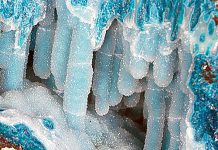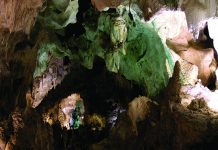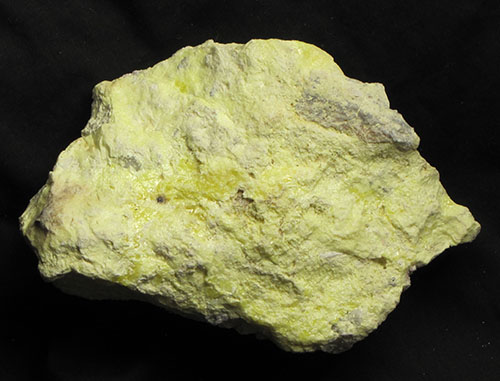
By Steve Voynick
With their nearly transparent, sharp-edged, bipyramidal and tabular crystals, fine specimens of sulfur are eminently collectible. But it is sulfur’s color — a pure yellow so intense that it seems to glow — that really catches the eye.
Fine specimens have come from many localities, most notably Italy. During the 19th century, Sicily’s vast evaporite deposits supplied most of the world’s sulfur, but the last of Sicily’s mines closed in the 1980s, victims of sweeping technological changes that are bringing down the curtain on the sulfur mining industry.
Sulfur’s Presence
Elemental sulfur most often crystallizes in the orthorhombic system; two rare, sulfur polymorphs crystallize in the monoclinic system. Sulfur is brittle and has a resinous luster. Depending upon the presence of impurities, it is transparent to translucent, with colors ranging from bright, dandelion yellow to subdued grays and browns. Elemental sulfur has a Mohs hardness of 1.5-2.5, a low specific gravity of 2.07, and a very low melting point of 226°F.
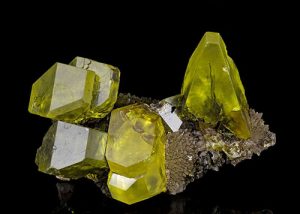
Sulfur is the 10th most abundant element in the earth’s crust, but because most sulfur is bound up in sulfate and sulfide minerals, organic and biomass materials, and coal and petroleum, relatively little exists in its native state.
Elemental sulfur occurs in evaporite concentrations in sedimentary rocks, and as earthy and encrusting forms at certain hot springs, fumaroles, and volcanic vents. Most importantly, it forms massive deposits within the limestone caprock that overlies many underground salt domes.
Early Uses
Sulfur’s earliest important use was as a component of gunpowder, which was invented in China in the 9th century. By the time gunpowder became widely used in Europe in the 1400s, most sulfur was obtained by roasting pyrite (iron disulfide). In the 1800s, demand for sulfur soared when it became the primary feedstock for the large-scale, industrial manufacture of sulfuric acid, which remains the most widely used inorganic chemical. By then, Sicily’s mines had become the world’s leading source of sulfur.
In 1894, American industrial chemist Hermann Frasch developed a method to tap the massive deposits of elemental sulfur associated with underground salt domes. Frasch drilled wells into sulfur deposits and injected superheated water to melt the sulfur. Subsequent injection of compressed air forced the liquid sulfur into extraction wells for transport to the surface. “Frasch mining” of the huge salt-sulfur domes of Louisiana and Texas soon made the United States the world’s leading sulfur producer and triggered the long, steady decline of sulfur mining in Sicily.
Frasch mining dominated global sulfur production until the 1970s, when it, too, became a victim, this time to environmental concerns and clean-air regulations that mandated the capture of the huge volumes of sulfur-based gases emitted by metal smelters, coal-fired power plants, petroleum refineries, and natural-gas processing plants.
Smokestack Scrubbing for Sulfur
The vast tonnages of cheap sulfur recovered from countless smokestack scrubbers quickly made Frasch mining uneconomical. Today, the Kawah Ijen volcano on the Indonesian island of Java is one of the world’s last conventional sulfur mines. Inside its 9,000-foot-high crater, miners dig thick encrustations of sulfur that formed from direct sublimation of volcanic gases. Today, conventional mining and the last remaining Frasch operation in Poland account for a mere 2% of the 70 million tons of sulfur now recovered worldwide each year.
Thanks to recoveries from smokestack scrubbers, the United
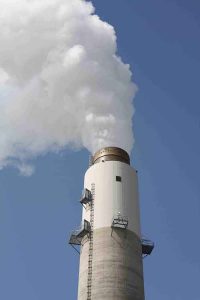
States, with no remaining elemental sulfur mines or Frasch operations, is self-sufficient in sulfur and the world’s second-largest producer. Yet, just the opposite scenario exists in China, the world’s leading sulfur producer. With few clean-air restrictions, China recovers very little smokestack sulfur. Most of its 10 million-ton annual production comes from the archaic and heavily polluting practice of roasting pyrite—it’s the last nation to do so.
In the not-distant future, all sulfur will come from smokestack scrubbers. With the demise of conventional sulfur mining, it’s a good bet that the finest sulfur specimens have already been collected.
Author: Steve Voynick
 A science writer, mineral collector, and former hard rock miner, he is also the author of many references including, “Colorado Rock Hounding” and “New Mexico Rockhounding.”
A science writer, mineral collector, and former hard rock miner, he is also the author of many references including, “Colorado Rock Hounding” and “New Mexico Rockhounding.”



